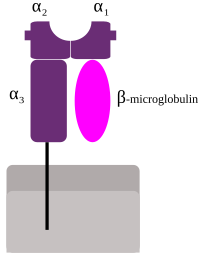
Photo from wikipedia
OBJECTIVE Stevens-Johnson syndrome (SJS) and toxic epidermal necrolysis (TEN) are severe cutaneous adverse drug reactions. Antiseizure medications (ASMs) with aromatic ring structure, including carbamazepine, are among the most common culprits.… Click to show full abstract
OBJECTIVE Stevens-Johnson syndrome (SJS) and toxic epidermal necrolysis (TEN) are severe cutaneous adverse drug reactions. Antiseizure medications (ASMs) with aromatic ring structure, including carbamazepine, are among the most common culprits. Screening for human leukocyte antigen (HLA) allele HLA-B*15:02 is recommended prior to initiating treatment with carbamazepine in Asians, but this allele has low positive predictive value. METHODS We performed whole genome sequencing and analyzed 6 199 696 common variants among 113 aromatic ASM-induced SJS/TEN cases and 84 tolerant controls of Han Chinese ethnicity. RESULTS In the primary analysis, nine variants reached genome-wide significance (p < 5e-08), one in the carbamazepine subanalysis (85 cases vs. 77 controls) and a further eight identified in HLA-B*15:02-negative subanalysis (35 cases and 53 controls). Interaction analysis between each novel variant from the primary analysis found that five increased risk irrespective of HLA-B*15:02 status or zygosity. HLA-B*15:02-positive individuals were found to have reduced risk if they also carried a chromosome 12 variant, chr12.9426934 (heterozygotes: relative risk = .71, p = .001; homozygotes: relative risk = .23, p < .001). All significant variants lie within intronic or intergenic regions with poorly understood functional consequence. In silico functional analysis of suggestive variants (p < 5e-6) identified through the primary and subanalyses (stratified by HLA-B*15:02 status and drug exposure) suggests that genetic variation within regulatory DNA may contribute to risk indirectly by disrupting the regulation of pathology-related genes. The genes implicated were specific either to the primary analysis (CD9), HLA-B*15:02 carriers (DOCK10), noncarriers (ABCA1), carbamazepine exposure (HLA-E), or phenytoin exposure (CD24). SIGNIFICANCE We identified variants that could explain why some carriers of HLA-B*15:02 tolerate treatment, and why some noncarriers develop ASM-induced SJS/TEN. Additionally, this analysis suggests that the mixing of HLA-B*15:02 carrier status in previous studies might have masked variants contributing to susceptibility, and that inheritance of risk for ASM-induced SJS/TEN is complex, likely involving multiple risk variants.
Journal Title: Epilepsia
Year Published: 2022
Link to full text (if available)
Share on Social Media: Sign Up to like & get
recommendations!